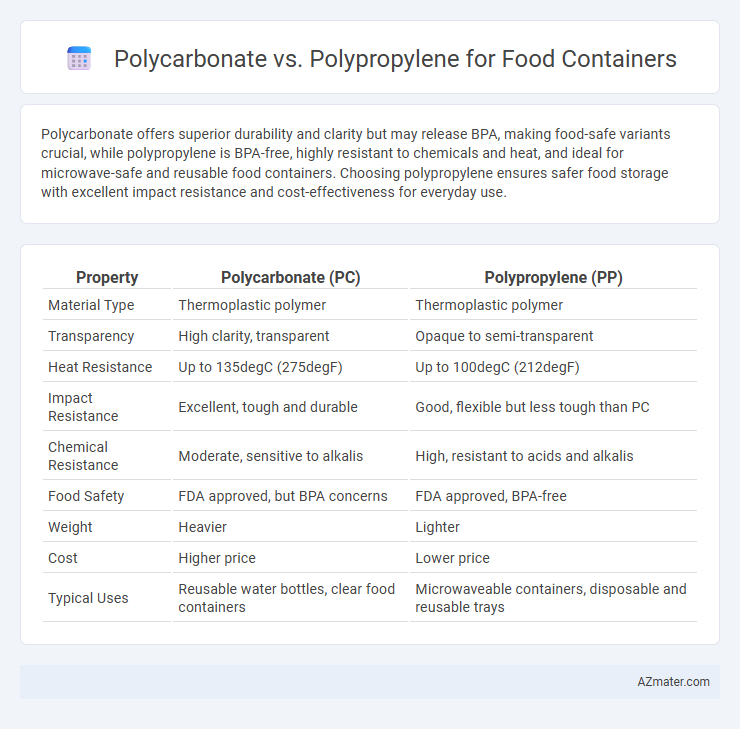Polycarbonate offers superior durability and clarity but may release BPA, making food-safe variants crucial, while polypropylene is BPA-free, highly resistant to chemicals and heat, and ideal for microwave-safe and reusable food containers. Choosing polypropylene ensures safer food storage with excellent impact resistance and cost-effectiveness for everyday use.
Table of Comparison
| Property | Polycarbonate (PC) | Polypropylene (PP) |
|---|---|---|
| Material Type | Thermoplastic polymer | Thermoplastic polymer |
| Transparency | High clarity, transparent | Opaque to semi-transparent |
| Heat Resistance | Up to 135degC (275degF) | Up to 100degC (212degF) |
| Impact Resistance | Excellent, tough and durable | Good, flexible but less tough than PC |
| Chemical Resistance | Moderate, sensitive to alkalis | High, resistant to acids and alkalis |
| Food Safety | FDA approved, but BPA concerns | FDA approved, BPA-free |
| Weight | Heavier | Lighter |
| Cost | Higher price | Lower price |
| Typical Uses | Reusable water bottles, clear food containers | Microwaveable containers, disposable and reusable trays |
Introduction to Food-Safe Plastics
Polycarbonate and polypropylene are widely used food-safe plastics, each offering distinct advantages for food container applications. Polycarbonate provides excellent clarity and high impact resistance, while polypropylene features superior chemical resistance and flexibility, making it ideal for both hot and cold food storage. Both materials comply with FDA regulations for food contact, ensuring safety and durability for everyday use.
Overview of Polycarbonate and Polypropylene
Polycarbonate is a durable, transparent thermoplastic known for high impact resistance and heat tolerance, commonly used in reusable food containers requiring clarity and toughness. Polypropylene is a lightweight, semi-crystalline polymer celebrated for its excellent chemical resistance, low moisture absorption, and flexibility, making it ideal for disposable or microwave-safe food containers. Both materials comply with FDA food safety standards but differ in temperature tolerance and recyclability, influencing their specific applications in food storage.
Chemical Structure and Composition
Polycarbonate consists of bisphenol A units linked by carbonate groups, offering a rigid, transparent plastic with strong impact resistance, making it ideal for food containers requiring clarity and durability. Polypropylene, a polymer of propylene monomers, features a semi-crystalline structure with methyl side groups, providing excellent chemical resistance and flexibility but lower transparency. The aromatic carbonate groups in polycarbonate contribute to thermal stability and structural rigidity, while polypropylene's saturated hydrocarbon backbone results in better resistance to acids and bases but reduced stiffness.
Safety and Food Contact Approvals
Polycarbonate and polypropylene differ significantly in safety and food contact approvals, with polypropylene widely recognized for its excellent chemical resistance and FDA approval for direct food contact, making it a preferred choice for food containers. Polycarbonate, containing BPA, has faced scrutiny and restrictions due to potential health risks, though BPA-free versions are available and meet certain regulatory standards like the EU's food contact regulations. Selecting polypropylene ensures compliance with global food safety standards, reducing the risk of chemical leaching and ensuring safer storage for various food types.
Heat Resistance and Temperature Tolerance
Polycarbonate offers superior heat resistance with a melting point around 155degC, making it suitable for repeated use in microwaves and dishwashers without deformation. Polypropylene has a higher temperature tolerance, melting near 160-170degC, but can soften above 100degC, limiting its use in high-heat applications. For food containers requiring durability under heat, polycarbonate provides better stability, while polypropylene is cost-effective for moderate temperature exposure.
Durability and Impact Resistance
Polycarbonate offers superior durability and impact resistance compared to polypropylene, making it ideal for food containers that require long-lasting performance and resistance to cracking or breaking. Polycarbonate's ability to withstand high impact forces without deforming ensures enhanced protection for stored food, even in demanding environments. Polypropylene, while more flexible and resistant to chemical corrosion, generally has lower impact resistance and may degrade faster under repeated stress.
Clarity and Aesthetic Appeal
Polycarbonate offers superior clarity with a glass-like transparency that enhances the visibility of food, making it ideal for elegant display containers. Polypropylene, while more opaque and less glossy, provides a softer matte finish that is durable but less visually striking. For food containers where aesthetic appeal and clear presentation are priorities, polycarbonate is the preferred material due to its high optical clarity and polished appearance.
Dishwasher and Microwave Compatibility
Polycarbonate containers typically offer superior dishwasher durability and microwave safety due to their high heat resistance, withstanding temperatures up to 120degC without warping or releasing harmful chemicals. Polypropylene containers also provide good dishwasher compatibility and can generally handle microwave heating safely, but they have lower heat tolerance, usually up to around 100degC, which may cause deformation in high-temperature cycles. Choosing polycarbonate ensures extended usability in both dishwashers and microwaves, while polypropylene offers a cost-effective alternative with moderate heat resistance suitable for everyday food storage.
Environmental Impact and Recyclability
Polycarbonate, derived from bisphenol A (BPA), presents environmental concerns due to BPA's potential toxicity and difficulties in recycling processes that often require specialized facilities, limiting its eco-friendliness. Polypropylene, a widely recyclable thermoplastic, offers a lower environmental impact with its higher recyclability rates and more straightforward processing in municipal recycling systems, supporting circular economy goals. Choosing polypropylene over polycarbonate for food containers aligns better with sustainable practices by minimizing hazardous chemical release and enhancing material reuse potential.
Which Material is Best for Food Containers?
Polycarbonate offers excellent durability, clarity, and heat resistance, making it ideal for food containers requiring transparency and repeated microwave or dishwasher use. Polypropylene excels in chemical resistance, lightweight properties, and affordability, which suits disposable or low-cost food storage solutions. For long-term food storage and frequent reuse, polycarbonate is typically preferred, while polypropylene is better for budget-friendly, single-use containers.

Infographic: Polycarbonate vs Polypropylene for Food container
 azmater.com
azmater.com